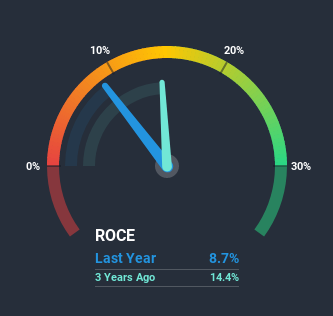How Well Is American Renal Associates Holdings (NYSE:ARA) Allocating Its Capital?
To avoid investing in a business that's in decline, there's a few financial metrics that can provide early indications of aging. Typically, we'll see the trend of both return on capital employed (ROCE) declining and this usually coincides with a decreasing amount of capital employed. This reveals that the company isn't compounding shareholder wealth because returns are falling and its net asset base is shrinking. So after glancing at the trends within American Renal Associates Holdings (NYSE:ARA), we weren't too hopeful.
What is Return On Capital Employed (ROCE)?
If you haven't worked with ROCE before, it measures the 'return' (pre-tax profit) a company generates from capital employed in its business. To calculate this metric for American Renal Associates Holdings, this is the formula:
Return on Capital Employed = Earnings Before Interest and Tax (EBIT) ÷ (Total Assets - Current Liabilities)
0.087 = US$79m ÷ (US$1.2b - US$251m) (Based on the trailing twelve months to September 2020).
So, American Renal Associates Holdings has an ROCE of 8.7%. In absolute terms, that's a low return but it's around the Healthcare industry average of 11%.
Check out our latest analysis for American Renal Associates Holdings
Above you can see how the current ROCE for American Renal Associates Holdings compares to its prior returns on capital, but there's only so much you can tell from the past. If you'd like to see what analysts are forecasting going forward, you should check out our free report for American Renal Associates Holdings.
So How Is American Renal Associates Holdings' ROCE Trending?
There is reason to be cautious about American Renal Associates Holdings, given the returns are trending downwards. To be more specific, the ROCE was 18% five years ago, but since then it has dropped noticeably. Meanwhile, capital employed in the business has stayed roughly the flat over the period. Companies that exhibit these attributes tend to not be shrinking, but they can be mature and facing pressure on their margins from competition. So because these trends aren't typically conducive to creating a multi-bagger, we wouldn't hold our breath on American Renal Associates Holdings becoming one if things continue as they have.
On a side note, American Renal Associates Holdings' current liabilities have increased over the last five years to 22% of total assets, effectively distorting the ROCE to some degree. Without this increase, it's likely that ROCE would be even lower than 8.7%. While the ratio isn't currently too high, it's worth keeping an eye on this because if it gets particularly high, the business could then face some new elements of risk.
What We Can Learn From American Renal Associates Holdings' ROCE
In summary, it's unfortunate that American Renal Associates Holdings is generating lower returns from the same amount of capital. Investors haven't taken kindly to these developments, since the stock has declined 39% from where it was three years ago. With underlying trends that aren't great in these areas, we'd consider looking elsewhere.
On a final note, we've found 2 warning signs for American Renal Associates Holdings that we think you should be aware of.
While American Renal Associates Holdings isn't earning the highest return, check out this free list of companies that are earning high returns on equity with solid balance sheets.
This article by Simply Wall St is general in nature. It does not constitute a recommendation to buy or sell any stock, and does not take account of your objectives, or your financial situation. We aim to bring you long-term focused analysis driven by fundamental data. Note that our analysis may not factor in the latest price-sensitive company announcements or qualitative material. Simply Wall St has no position in any stocks mentioned.
Have feedback on this article? Concerned about the content? Get in touch with us directly. Alternatively, email editorial-team (at) simplywallst.com.

